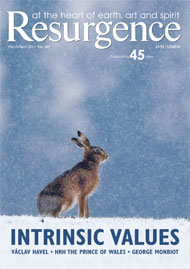David Abram is a true magician, superbly skilled in both sleight-of-hand magic and the literary art of awakening us to the superabundant wonders of the natural world. He is one of America’s greatest Nature writers, and this book is the long-awaited sequel to his earlier masterpiece The Spell of the Sensuous, which restores to modern consciousness the ancient animistic sensibility that everything is saturated with soul.
The essential achievement of Spell was the revelation of how all beings, living and non-living, palpably bring us home to the pulsing heart of the world when we listen to their long-stifled voices, and in Becoming Animal Abram carries us off on new and enlivening journeys into the radically exciting possibilities of this animistic style of perception.
This is a book of such transformative potential that it needs to be read twice in quick succession to get the full benefit. I did just this, starting again as soon as I had finished my first reading so that I could savour much that I had missed in that first immersion. The language is luminous, the style hypnotic. Abram weaves a spell that brings the world alive before your very eyes, as everyday things that seemed dead take on new life, new meaning and a new purpose.
Take shadows. For Abram, they are the remains of the night’s sentience that survive the day by glueing themselves to objects exposed to the glaring light of the sun. As the sun disappears behind the horizon, shadows slowly seep back into the world. And when night finally arrives, we are carried into the “mammoth shadow of the Earth” and hence into the particular style of awareness adopted by the very Earth itself as it contemplates the vast spaces of its intergalactic habitat, speckled with stars and planets.
Abram also enlivens our taken-for-granted sense of depth with the transformative power of his perceptual magic. When deep in the mountains, he enters into that “elixir state of mind called ‘wilderness’”, in which the landscape reveals its psyche by metamorphosing around him as he explores its rugged contours. He experiences the landscape walking past him rather than the other way around.
Thus does the world reveal itself in its ambiguous depths as Abram discovers himself deeply inside the physical world. Even clouds, he says, are part of our turning world, pulled as they are by the thickness of the atmosphere itself. So he gives us a new word, Eairth, to remind us that the air is as much a part of the Earth as the biosphere, the waters and the rocks, and that our ‘i’, or self is totally immersed in the swirling air. Eairth implies that we live in the Earth and not merely on it as disconnected observers.
I hope that by now you are beginning to sense the measure of this marvellous book. But perhaps you also feel a certain scepticism creeping into your bones. For how can it be that inert objects and even mere shadows are alive? Isn’t Abram indulging in an anthropomorphic projection, valuable as poetry, perhaps, but certainly not a genuine way of knowing? Abram counters this by pondering the possibility that it was this very animistic sensibility that helped our ancestors to survive, for they could not have flourished without being able to discern the shifting mood of a winter sky, or without a felt rapport with all the complex entities in their immediate surroundings.
I find these arguments compelling, suggesting as they do that that our senses are finely tuned to the rhythms and patterns of the animate Earth because the biosphere is, after all, the primordial creative matrix from which we emerged as a species.
I have given you only the slightest hint of the many and varied treasures that lie waiting for you in this hugely important book. Now you must read it for yourself as a matter of urgency. For there is little chance that we will discover the restraint that we so urgently need to survive the massive global crisis that we have unleashed upon the world unless we learn to sense the world around us as a mysterious animate being that merits our deepest care and respect.






